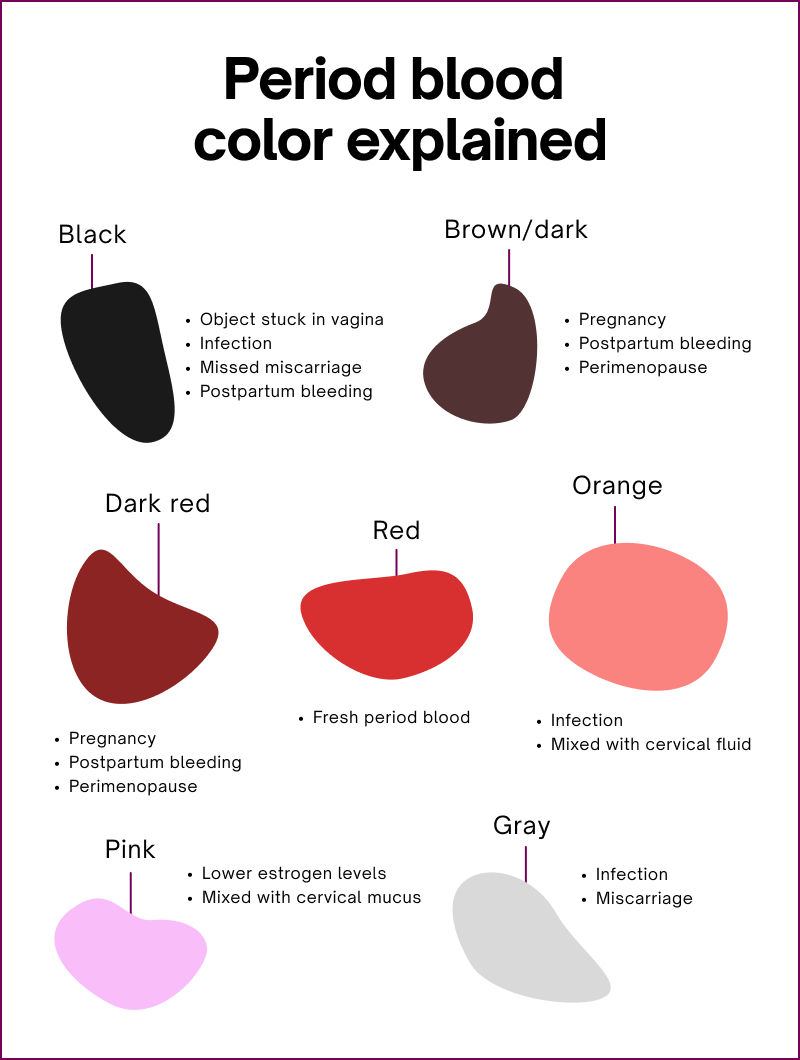What does the color of period blood mean?
Key takeaways:
- Period blood isn’t always red. In fact, period colors can vary depending on what stage you’re at in your cycle and whether there are any other health concerns
- Changes in period blood colors are usually simply an indication of how fresh the blood is — although there are other potential reasons for color variations too, including infections and pregnancy
On this page
- Different period colors
- What does black period blood mean?
- What does brown or dark red period blood mean?
- What does bright red period blood mean?
- What does pink period blood mean?
- What does orange period blood mean?
- What does gray period blood mean?
- What does changing blood color during a period mean?
- Is it normal for period blood to have clots?
- When to see a doctor about period blood color changes
- Get to know your own body better
Different period colors
When you think of period blood, you might think of it being bright red – but have you ever noticed that the shade of your period blood varies?
It’s important to know that no two people are the same, and what’s normal for you may not be normal for someone else. It’s totally normal for the color of your period blood to change from cycle to cycle, and even within one period. It might be dark right at the start of your period before changing to bright red and getting lighter towards the tail end of your period.
What does black period blood mean?
It may be worrying to see black blood – but it’s not necessarily a cause for concern. In most cases, black period blood is old blood that’s taken a while to exit your body. When menstrual blood stays in the uterus for an extended period, it goes through a process of oxidation and is exposed to oxygen – which can lead to a darker color.
This usually happens at the start or end of your period and is completely normal. There are some other potential causes of black period blood as well, which may indicate something more serious, such as:
Something trapped inside your vagina
If something is trapped, like a forgotten tampon, an old condom, a cervical cap or diaphragm, or a sex toy, it could cause dark blood. If this is the cause of black blood, you’ll likely have other symptoms too, like an unpleasant smell, itching, a rash on your vulva, and a fever. If you have these symptoms along with black period blood, you should speak to a doctor or healthcare professional immediately.
Infection
Black period blood could also be a sign of an infection, such as pelvic inflammatory disease or a sexually transmitted infection. Again, you’ll usually have other symptoms alongside unusual bleeding, like painful urination, itching, and pelvic pain. If you think you may have an infection, you should see a healthcare professional as soon as possible.
Missed miscarriage
Black blood can be a sign of a missed miscarriage. Missed miscarriage, also known as a silent miscarriage, is a common form of pregnancy loss where bleeding does not happen right away when a pregnancy ends. If you are pregnant or suspect you’re pregnant and notice black blood, it could indicate a missed miscarriage – so it’s crucial that you speak to a medical professional as soon as possible.
Lochia
Lochia is postpartum bleeding that usually happens for six to eight weeks after childbirth. It includes blood, tissue, and mucus that are discharged from the uterus, and in the first few days after giving birth, lochia is usually bright red.
Over time, the flow tends to decrease, and the color changes from bright red to red, pink, or brown. If the flow is slow, the lochia may be black – which simply signifies that the blood is older and has undergone oxidation while waiting to be expelled from the body.
What does brown or dark red period blood mean?
Brown period blood, or blood that’s dark red, usually comes at the start or end of your period – and much like black blood, it can mean that it’s old blood that’s had time to oxidize before leaving the body. It can also indicate:
Pregnancy
Brown period blood could be a sign of implantation bleeding, a type of light bleeding or spotting that is thought to happen very early in a pregnancy — although the evidence for this phenomenon is limited. Implantation bleeding is thought to be caused by the fertilized egg cell coming into contact with blood cells in the uterus lining as it implants into the uterine wall. Implantation bleeding is thought to occur around 10 to 14 days after conception. Some other early pregnancy signs include cramps, swollen breasts, nausea, and vomiting.
Whether you’re trying to get pregnant or want to avoid it, it’s a good idea to keep track of your periods. While there are plenty of period trackers out there, Natural Cycles is a temperature-based app that learns the pattern of your unique cycle so you can plan or prevent pregnancy naturally. You’ll also learn all about your own menstrual health and can track changes you experience throughout the cycle.
Postpartum bleeding
As well as being black-colored, postpartum bleeding or lochia can also be brown or dark red.
Perimenopause
Brown or dark red period blood can also be a sign of perimenopause, the transitional timeframe leading up to menopause. During this time, hormonal changes can impact the menstrual cycle and the appearance of your menstrual bleeding. As you approach menopause, your ovaries produce fewer hormones, which can cause changes in your menstrual cycle, including more irregular periods, a lighter or heavier flow, and darker-colored blood, indicating that it’s taken some time to exit the uterus.
What does bright red period blood mean?
Some people may have bright red blood throughout their period, while for others, it only happens in the middle of their period when their flow is at its heaviest. Bright red indicates that the blood is relatively fresh and hasn’t been exposed to oxygen for an extended period. It’s entirely normal to have red period blood, and shouldn’t be anything to worry about.
What does pink period blood mean?
Many people experience pink blood at the beginning or end of their period, and this is often caused by the mixing of cervical mucus or other fluids and menstrual blood.
Pink blood can also be a result of lower estrogen levels, which can be caused by hormonal birth control. Estrogen plays a crucial role in maintaining your uterine lining – and when estrogen levels are lower, the uterine lining may be thinner, leading to lighter pink blood.
What does orange period blood mean?
Link pink period blood, and orange-colored bleeding may be caused by menstrual blood mixing with cervical fluid. It may also be caused by an infection, like bacterial vaginosis or trichomoniasis, a type of sexually transmitted infection caused by a small parasite.
If orange period blood is caused by an infection, it’ll usually be accompanied by other symptoms, including vaginal itching and a bad smell – and you should always get these symptoms checked out by a professional for proper diagnosis and treatment.
What does gray period blood mean?
Gray isn’t a typical color for period blood and may be cause for concern, and you should seek medical advice to get the appropriate treatment. Gray-colored blood may indicate various things, such as:
An infection
An infection in the reproductive tract can cause changes in the color of menstrual blood or different colored discharge. Infections may be accompanied by other symptoms like unusual odor, itching, pain, or discomfort.
Miscarriage
In some cases, gray discharge or blood can be associated with a miscarriage, particularly if accompanied by other symptoms like pain in your lower tummy. If you suspect a miscarriage or have concerns about your pregnancy, seek medical attention immediately.

What does changing blood color during a period mean?
It’s totally normal for your period blood to change color from the beginning to the middle to the end of your period.
Most people will have pink or bright red bleeding at the start of their period as the blood is fresh, then the blood may become brown, dark red, or black later in your period as the blood’s been in your uterus for longer, giving it more time to oxidize.
However, changes in color can also be a cause for concern, with gray, orange, dark brown or black blood all potentially indicating a potentially more serious cause. So if you ever notice any period blood colors that are unusual for you, it’s important to get it checked out.
Is it normal for period blood to have clots?
It’s normal for menstrual blood to have clots. They’re usually caused by blood clumping together as your uterus sheds its lining, leading to the release of blood. They can be more common when you have a heavy flow – but if you notice particularly big period blood clots, especially if they’re accompanied by heavy bleeding or other concerning symptoms, it’s a good idea to seek medical advice.
When to see a doctor about period blood color changes
Variation in period blood colors is normal, but there are some instances when you should consider seeing a doctor, particularly if your blood or discharge is gray or another color that’s unusual for you.
You should also keep an eye out for any other unusual changes to your period, which could necessitate a trip to the doctor. These include:
- Particularly heavy periods
- Extremely short or very long periods
- No period for three months or longer
- Severe pain alongside your period
- Bleeding or spotting between periods
- Bleeding when you’re pregnant
Most of these symptoms are nothing to worry about – but it’s always worth getting any unusual symptoms checked out.
Get to know your own body better
Here at Natural Cycles, we’re on hand to help you learn more about your cycle so you can predict and prepare for symptoms such as PMS, menstrual cramps, and more. With our birth control app, it’s easy to document symptoms and keep track of your unique cycle, making it easier to spot patterns in your cycle and keep track of your PMS symptoms so you’ll be better prepared for your period arriving.
The first FDA-cleared birth control app, Natural Cycles, can help you plan or prevent pregnancy on your timeline. Why not find out if it could work for you today?
Did you enjoy reading this article?
